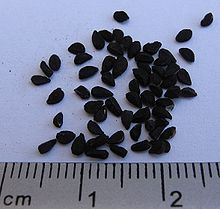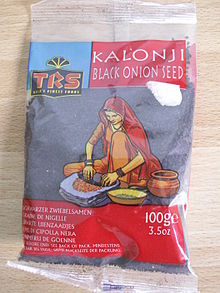- Nigella sativa
-
Nigella sativa 
Scientific classification Kingdom: Plantae Division: Magnoliophyta Class: Magnoliopsida Order: Ranunculales Family: Ranunculaceae Genus: Nigella Species: N. sativa Binomial name Nigella sativa
L.Nigella sativa is an annual flowering plant, native to south and southwest Asia. It grows to 20–30 cm (7.9–12 in) tall, with finely divided, linear (but not thread-like) leaves. The flowers are delicate, and usually coloured pale blue and white, with five to ten petals. The fruit is a large and inflated capsule composed of three to seven united follicles, each containing numerous seeds. The seed is used as a spice.
Contents
Etymology
The scientific name is a derivative of Latin niger (black).[1]
Common names
In English, Nigella sativa seed is variously called fennel flower, nutmeg flower, Roman coriander, blackseed or black caraway. Other names used, sometimes misleadingly, are onion seed and black sesame, both of which are similar-looking, but unrelated.
The seeds are frequently referred to as black cumin (as in Assamese: kaljeera or kolajeera or Bengali kalo jeeray), In south Indian language Kannada it is called "Krishna Jeerige", but this is also used for a different spice, Bunium persicum. Original black cumin seed is Carum bulbocastanum.[2]
In English-speaking countries with large immigrant populations, it is also variously known as kaljeera (Assamese কালজীৰা kalzira or ক’লাজীৰা kolazira), kalo jira (Bengali: কালোজিরা kalojira, black cumin), karum cheerakam (Tamil கருஞ்சீரகம்), kalonji (Hindi/Urdu कलौंजी kalauṃjī or كلونجى/कलोंजी kaloṃjī) or mangrail (Hindi मंगरैल maṃgarail), ketzakh (Hebrew קצח), chernushka (Russian), çörek otu (Turkish), habbat al-barakah (Arabic حبه البركة ḥabbat al-barakah, seed of blessing), siyah daneh (Persian سیاهدانه siyâh dâne), jintan hitam (Indonesian), karim jeerakam in Malayalam or කළු දුරු in Sinhala, Karto Jeera in (Beary Language).
It is used as part of the spice mixture paanch phoran or panch phoron (meaning a mixture of five spices) and by itself in a great many recipes in Bengali cookery and most recognizably in naan bread.[3]
The Turkish name çörek otu literally means "bun's herb" from its use in flavouring the çörek buns. Such braided-dough buns are widespread in the cuisines of Turkey and its neighbors (see Tsoureki τσουρέκι). In Bosnian, the Turkish name for Nigella sativa is respelled as čurekot. The seed is used in Bosnia, and particularly its capital Sarajevo, to flavour pastries (Bosnian: somun) often baked on Muslim religious holidays.
Characteristics
Nigella sativa has a pungent bitter taste and smell. It is used primarily in confectionery and liquors. Peshawari naan is, as a rule, topped with kalonji seeds.
History
According to Zohary and Hopf, archeological evidence about the earliest cultivation of N. sativa "is still scanty", but they report supposed N. sativa seeds have been found in several sites from ancient Egypt, including Tutankhamun's tomb.[4] Although its exact role in Egyptian culture is unknown, it is known that items entombed with a pharaoh were carefully selected to assist him in the afterlife.
The earliest written reference to N. sativa is thought to be in the book of Isaiah in the Old Testament, where the reaping of nigella and wheat is contrasted (Isaiah 28: 25, 27). Easton's Bible dictionary states the Hebrew word ketsah refers to N. sativa without doubt (although not all translations are in agreement). According to Zohary and Hopf, N. sativa was another traditional condiment of the Old World during classical times; and its black seeds were extensively used to flavor food.[4]
History of medicine
In Islam, it is regarded as one of the greatest forms of healing medicine available. In the Unani Tibb system of medicine, black cumin is regarded as a valuable remedy for a number of diseases. Sayings of Islamic prophet Mohammed underline the significance of Nigella sativa. According to a hadith narrated by Abu Hurerah, he says, "I have heard Hazrat Muhammad saying that the black granules (kalonji) is the remedy for all diseases except death." [5]
The seeds have been traditionally used in the Middle East and Southeast Asian countries to treat ailments including asthma, bronchitis, rheumatism and related inflammatory diseases, to increase milk production in nursing mothers, to promote digestion and to fight parasitic infections. Its many uses have earned black cumin seed the Arabic approbation Habbatul barakah, meaning the "seed of blessing".
Its oil has been used to treat skin conditions, such as eczema and boils, and to treat cold symptoms. Many researchers have recently also studied its reaction towards cancer, and it is said to have many anticancer properties.[citation needed]
Black cumin
Original black cumin (Carum bulbocastanum) is rarely available, so N. sativa is widely used instead; (in India, Carum carvi is the substitute). Cumins are from Apiaceae or Umbelliferae (both names are allowed by the ICBN) family, but N. sativa is from Ranunculaceae family. Black cumin (not N. sativa) seeds come as paired or separate carpels, and are 3-4mm long. They have a striped pattern of nine ridges and oil canals, and are fragrant (Ayurveda says, "Kaala jaaji sugandhaa cha" (black cumin seed is fragrant itself), blackish in colour, boat-shaped, and tapering at each extremity, with tiny stalks attached; it has been used for medicinal purposes for centuries, both as a herb and pressed into oil, in Asia, the Middle East, and Africa. It has been traditionally used for a variety of conditions and treatments related to respiratory health, stomach and intestinal health, kidney and liver function, circulatory and immune system support, as analgesic, anti-inflammatory, antiallergic, antioxidants, anticancer, antiviral and for general well-being.
Scientific research
Nigella sativa oil (not black cumin seed oil) contains nigellone, which protects guinea pigs from histamine-induced bronchial spasms[6] (perhaps explaining its use to relieve the symptoms of asthma, bronchitis, and coughing).
The presence of an antitumor sterol, beta-sitosterol, lends credence to its traditional use to treat abscesses and tumors of the abdomen, eyes, and liver.[7]
N. sativa oil has been reported to be effective in treating opioid dependence.[8]
N. sativa also has been reported to reduce calculi formation in rats' kidneys.[9]
The oil contains melanthin, nigilline, damascene and tannin. Melanthin is toxic in large doses and nigelline is paralytic, so this spice must be used in moderation.
Thymoquinone and pancreatic cancer treatment
Researchers at the Kimmel Cancer Center at Thomas Jefferson University in Philadelphia have found that thymoquinone, an extract of N. sativa seed oil, blocked pancreatic cancer cell growth and killed the cells by enhancing the process of programmed cell death, (apoptosis), acting as an HDAC inhibitor. While the studies are in the early stages, the findings suggest thymoquinone could eventually have some use as a preventative strategy in patients who have gone through surgery and chemotherapy or in individuals who are at a high risk of developing cancer.[10]
Patents
Nigella Sativa currently has five (5) FDA separate patents in the U.S. and one (1) in the UK for the treatment of:[11]
- Diabetes (US 6,042,834)
- Inhibition of cancer cell growth (US 5,653,981)
- Improvement of the Immune System (US 5,482,711)
- Viral Infections (US 6,841,174)
- Psoriasis (US 6,531,164)
- Asthma (UK - EP1709995)
See also
- Nigella (genus)
References
- ^ New International Encyclopedia
- ^ KRSNAJIRAKA (Carum bulbocastanum)
- ^ http://www.chow.com/recipes/10516
- ^ a b Domestication of plants in the Old World (3 ed.). Oxford University Press. 2000. p. 206. ISBN 0198503563.
- ^ www.kokaniz.com/BenefitsofKalonjioil.doc
- ^ Effect of Nigella Sativa on Isolated Guinea Pig Trachea - PDF
- ^ Look for sterols at http://glycoscience.org/glycoscience/linksPage/links.html Click on the 4th listing for the GlycoScience link. (Link is dead of 2008-1-12)
- ^ Role Of Nigella Sativa In Opioid Dependence
- ^ http://www.sid.ir/En/VEWSSID/J_pdf/83020070206.pdf
- ^ "Traditional herbal medicine kills pancreatic cancer cells, researchers report.". May 19, 2008. http://www.physorg.com/news130410814.html.
- ^ Patents
External links
- Discover Nigella Sativa benefits
- Kalonji - by Dr. M. Laiq Ali Khan
- Nigella sativa
- Nigella from The Encyclopedia of Spices
- Ali BH, Blunden G (April 2003). "Pharmacological and toxicological properties of Nigella sativa". Phytother Res 17 (4): 299–305. doi:10.1002/ptr.1309. PMID 12722128.
- Antimicrobial activity of Nigella sativa oil against Staphylococcus aureus and Pseudomonas aeruginosa obtained from clinical specimens.
- Effects of Black Seeds (Nigella Sativa) on Spermatogenesis and Fertility of Male Albino Rats
- Effects of oral administration of water extract of Nigella sativa on serum concentrations of insulin and testosterone in alloxan-induced diabetic rats
Categories:- Ranunculaceae
- Medicinal plants
- Spices
- Herbs
Wikimedia Foundation. 2010.


